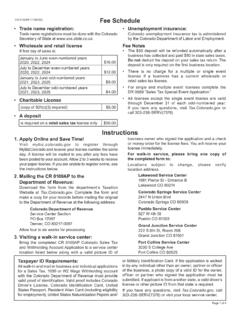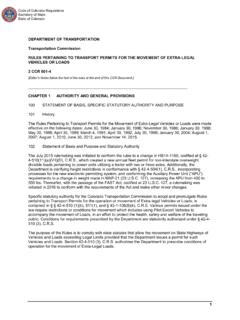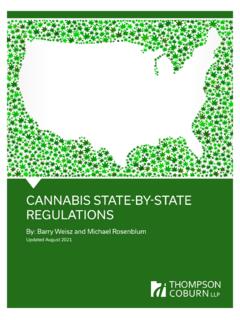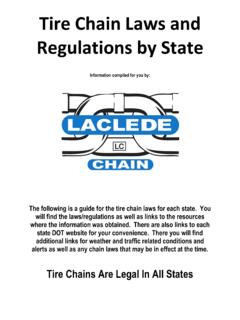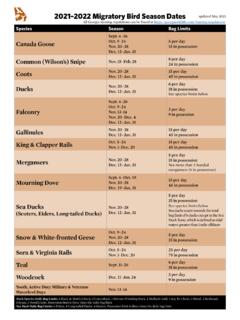Transcription of Income 35: Child Care Contribution Credit - Colorado
1 Page 1 of 3 (06/18) Income 35: Child care Contribution Credit Taxpayers that make a qualifying monetary Contribution to promote Child care in Colorado may claim an Income tax Credit of 50% of the total qualifying Contribution . The Credit a taxpayer can claim for qualifying contributions made during a tax year is limited to $100,000. In-kind contributions of services or property (non-monetary donations) do not qualify for the Credit . TAXPAYERS ELIGIBLE FOR THE Credit Any taxpayer that makes a qualifying Contribution can claim the Child care Contribution Credit . Resident and nonresident individuals, estates, trusts, and C corporations can all claim the Credit for qualifying contributions they make, either directly or as a partner or a shareholder in a partnership or S corporation that makes a qualifying Contribution .
2 QUALIFYING contributions contributions must meet several criteria to qualify for the Child care Contribution Credit . The Contribution must be monetary; contributions of services or property (including shares of stock) do not qualify for the Credit . The Credit is allowed only for contributions that promote Child care in Colorado . Additionally, the Contribution must be made for an eligible Child care purpose and to a licensed Child care facility, an approved facility school, or a registered or grandfathered Child care program. Finally, the Credit is not allowed for contributions which are specifically excepted. See contributions that do not qualify for the Credit below for additional information. Monetary contributions Monetary contributions eligible for the Credit are contributions of money made in cash, by check, or in some equivalent form.
3 Qualifying charitable distributions (QCD) made in accordance with federal law and IRS regulations from an individual retirement account (IRA) to a charitable organization are considered monetary contributions . See IRS Publication 590-B for additional information regarding QCDs. Eligible Child care purpose contributions must be made for an eligible Child care purpose to qualify for the Credit . Except in the case of grandfathered programs, discussed below, the Credit is only allowed for contributions made to promote Child care for children age 12 or younger. contributions for eligible Child care purposes are: donating money for the establishment or operation of any of the following: o a licensed Child care facility that uses the donation to provide Child care , o an approved facility school that uses the donation to provide Child care , o a registered Child care program that provides Child care services similar to those provided by licensed Child care centers (see Dept.)
4 Rule 1 CCR 201-2, 39-22-121(5)(a)(ix) for additional information), or o a grandfathered Child care program or facility; pooling moneys of several businesses and donating such moneys for the establishment of a licensed Child care facility; donating money to establish a registered grant or loan program for parents requiring financial assistance for Child care ; donating money to a registered program for the training of Child care providers; or donating money for the establishment of an information dissemination program that assists parents with information and referral services for Child care . Licensed Child care facilities and approved facility schools Licensed Child care facilities to which qualifying contributions can be made include the following facilities that are licensed by the Colorado Department of Human Services: Child care centers, Child placement agencies, family Child care homes, foster care homes, homeless youth shelters, residential Child care facilities, secure residential treatment centers, Page 2 of 3 (06/18) Qualifying contributions can also be made to any facility school approved by the Facility Schools Board that is also affiliated with a licensed or certified hospital in Colorado and is also a nonprofit organization.
5 A list of Child care facilities licensed by the Department of Human Services can be found online at Registered Child care programs Unlicensed Child care facilities and approved facility schools must register with the Department of Revenue to receive qualifying contributions . The Department publishes a list of registered unlicensed facilities on its website. The list of Accepted Unlicensed Child care Centers is available at , next to the link for FYI Income 35. A program can apply for registration by completing and submitting the Unlicensed Child care Organization Registration Application (Form DR 1318), specifying the eligible programs for which the contributions will be utilized, and including documentation regarding those specific programs.
6 Grandfathered programs and facilities Programs and facilities that received qualifying contributions prior to January 1, 2004 may qualify for exception from certain rules applicable to the Credit . Amendments to the law made in 2004 affected the types of contributions that qualified for the Credit . Prior to these amendments, credits were allowed for contributions made to programs and facilities without respect to licensure or registration and for contributions used to provide care for children up to the age of 18. Programs and facilities that received Credit -eligible contributions prior to January 1, 2004, that would not qualify thereafter due to the 2004 statutory changes, could apply for continued eligibility by completing Child care Contribution Tax Credit Grandfathered Organization Application (Form DR 1319).
7 See Department Rule 1 CCR 201-2, 39-22-121(7) for additional information about grandfathered programs and facilities. contributions that do not qualify for the Credit The law establishes several conditions that disqualify certain contributions for the Credit . contributions will not qualify for the Credit if any of the following apply: The Contribution is made to a Child care facility in which the taxpayer or a person related to the taxpayer has a financial interest. See Department Rule 1 CCR 201-2, 39-22-121(13)(a) for additional information about related taxpayers. The Contribution is made to a for-profit business and is not directly invested in the acquisition or improvement of facilities, equipment, or services, including the improvement of staff salaries, staff training, or the quality of Child care .
8 The Contribution is not directly related to promoting Child care in Colorado . The Contribution is made in a tax year commencing after December 31, 2024. The donor receives consideration from the donee organization in exchange for the Contribution . See Department Rule 1 CCR 201-2, 39-22-121(9)(e) for contributions made by companies for which the company s employees receive benefits. Investment funds contributions made to investment funds that yield future payments to eligible providers and organization qualify for the Credit only if 100% of the interest and principal the fund yields are utilized in a manner that qualifies for the Credit . CALCULATION OF THE Credit The Credit is equal to 50% of the taxpayer s qualifying Contribution made during the tax year except that the Credit a taxpayer can claim for any tax year cannot exceed $100,000.
9 The $100,000 limitation applies jointly to two taxpayers filing a joint Income tax return together. Additionally, the Credit is nonrefundable. Consequently, the amount of Credit a taxpayer uses for a given tax year (in combination with all other nonrefundable credits the taxpayer claims) cannot exceed the taxpayer s Income tax liability for that year. If a taxpayer s Credit exceeds the total tax due, the taxpayer can carry forward the excess Credit to the following tax year. Taxpayers can carry forward excess credits for up to five tax years, but must use the excess credits in the earliest tax year possible. Limitations for tax years 2011-2014 Various limitations regarding the amount of Credit a taxpayer could use applied to tax years 2011-2014.
10 See Department Rule 1 CCR 201-2, 39-22-121(2) and (8) for information about these limitations. Page 3 of 3 (06/18) contributions used for both qualified and nonqualified purposes If a Contribution is used for both qualified and nonqualified purposes, the Credit is allowed only for the part of the Contribution used for qualified purposes. The organization receiving the Contribution must allocate the Contribution between qualified and nonqualified purposes and report the allocation on the Child care Contribution Tax Credit Certification Form DR 1317 the organization provides to the donor. See Department Rule 1 CCR 201-2, 39-22-121(10)(b) for guidance regarding the allocation of contributions for qualified and nonqualified purposes.


